 Image: Brad Chacos/IDG
Image: Brad Chacos/IDGAt a Glance
Expert’s Rating
Pros
Superb 1440p performanceMuch quieter than Radeon Vega cardsNearly as powerful as GTX 1080
Cons
Nvidia restricts out-of-box clock speeds on custom cardsCurious value vs. GTX 1070 and GTX 1080
Our Verdict
Nvidia’s GTX 1070 Ti Founders Edition is a good card turned great in a graphics card market upset by cryptocurrency miners and wild prices.
Best Prices Today: GeForce GTX 1070 Ti Founders Edition
RetailerPriceNvidia$450View DealPrice comparison from over 24,000 stores worldwideProductPricePrice comparison from Backmarket
This GeForce GTX 1070 Ti review probably exists only because AMD’s Radeon Vega 56 exists.
Nvidia’s GTX-10 series debuted nearly a year and a half ago with the launch of the GeForce GTX 1070 and GTX 1080 in May, 2016. The more powerful card received price cuts since then—to $500, theoretically—but we never heard a whisper about a GeForce GTX 1070 Ti designed to slot between the two. Until AMD’s Radeon RX Vega graphics cards launched.
The disappointing Vega 64 ran hot and loud while failing to best the GTX 1080. But the (theoretically) $400 Radeon Vega 56 proved much more appealing—and its performance outpunches the GTX 1070 in many games. Surprise! Two months later the $450 GeForce GTX 1070 Ti appears, at a price just below what the $470 Vega 56 is actually selling for on the street.
But the quest to beat AMD puts the new hardware uncomfortably close to the GTX 1080—and Nvidia surprisingly restricted the card’s clock speeds to keep the GTX 1070 Ti from cannibalizing its bigger sibling. Well, kind of. Find out all in our Nvidia GeForce GTX 1070 Ti Founders Edition ($450 on Nvidia) and EVGA GTX 1070 Ti SC Black Edition ($470 on Amazon) review.
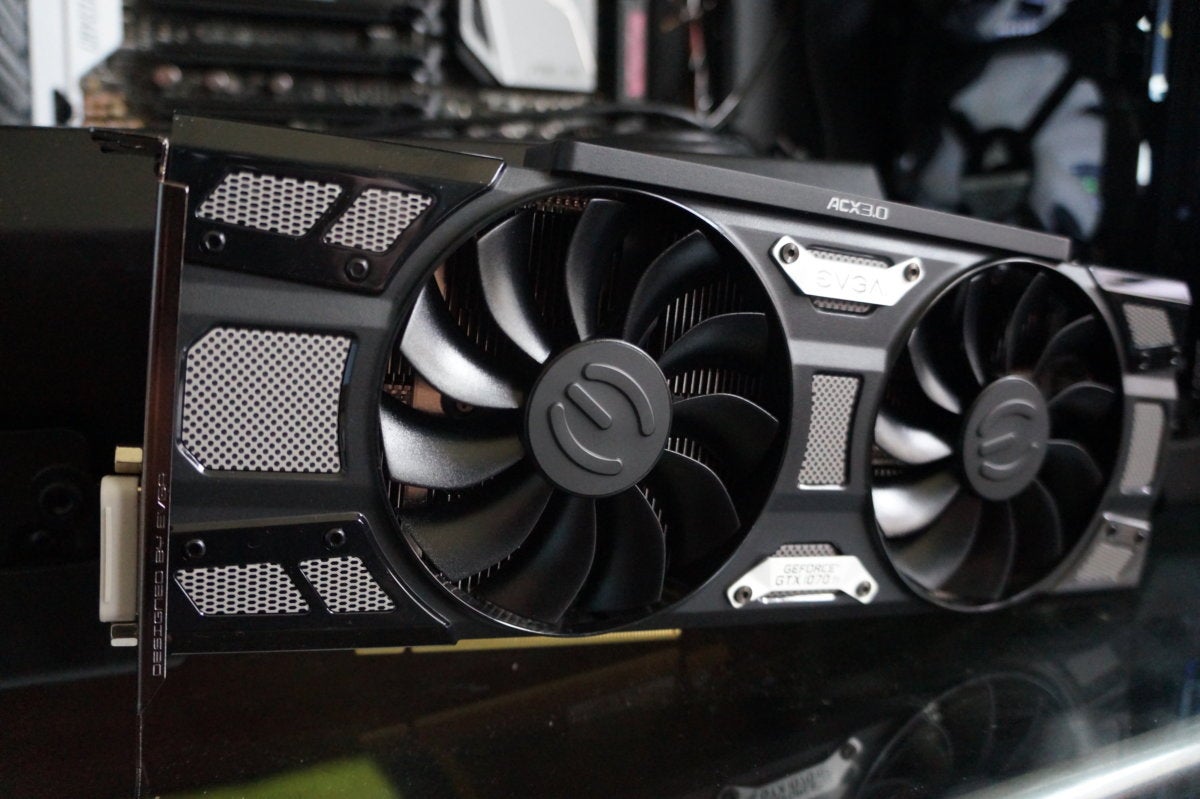 Brad Chacos/IDG
Brad Chacos/IDGThe EVGA GTX 1070 Ti SC Black Edition.
GeForce GTX 1070 Ti specs and features
The only truly surprising technical feature of the GeForce GTX 1070 Ti is how little Nvidia pared down its year-and-a-half-old “GP104” GPU compared to the GTX 1080. The full version of GP104 inside the GTX 1080 consists of 20 streaming multiprocessors (SMs) with 2,560 CUDA cores, while the GTX 1070 Ti’s chip has 19 SMs and a whopping 2,432 CUDA cores active. By comparison, the base GTX 1070 packs 15 SMs and just 1,920 CUDA cores.
The GTX 1070 Ti’s clock speeds swipe aspects from both sides. Nvidia’s new graphics card ships with a 1,607MHz base clock and 1,683MHz boost clock. By comparison, the GTX 1070 clocks at 1,506/1,683MHz, and the GTX 1080 hums along at 1,607/1,733MHz—at least on paper. In reality, Nvidia’s GPU Boost 3 technology runs these cards as fast as they’ll go while staying within optimal heat and power limits, especially in custom cards with powerful cooling solutions. But there’s an interesting twist to custom GTX 1070 Ti cards, which we’ll get into when we look at EVGA’s GTX 1070 Ti Black Edition in just a bit.
 Nvidia
NvidiaThe GeForce GTX 1070 Ti’s tech specs.
Nvidia built the GTX 1070 Ti Founders Edition to overclock well, despite some (slightly) misguided early rumors that suggested clock speeds would be locked down. It’s equipped with the same vapor chamber cooler and five-phase dual-FET power design as the GTX 1080 has, both of which aren’t found in the GTX 1070 vanilla.
But the GTX 1070 Ti’s memory subsystem mirrors the baseline GTX 1070’s, ditching the GTX 1080’s speedy GDDR5X memory for standard GDDR5 VRAM over a 256-bit bus. Like the vanilla version, the GTX 1070 Ti offers 256GBps of overall memory bandwidth, versus the GTX 1080’s 320GBps.
The Founders Edition card draws its 180W TDP through a single 8-pin power connector, and sports three DisplayPorts, an HDMI 2.0b port, and a dual-link DVI connection. The GTX 1070 Ti also supports Nvidia’s GeForce Experience software, including GFE’s stellar Ansel and ShadowPlay Highlights tools—features that actively makes your gaming experience more fun.
Next page: EVGA GTX 1070 Ti SC Black Edition and Precision XOC auto-overclocking
EVGA GTX 1070 Ti Black Edition specs and features
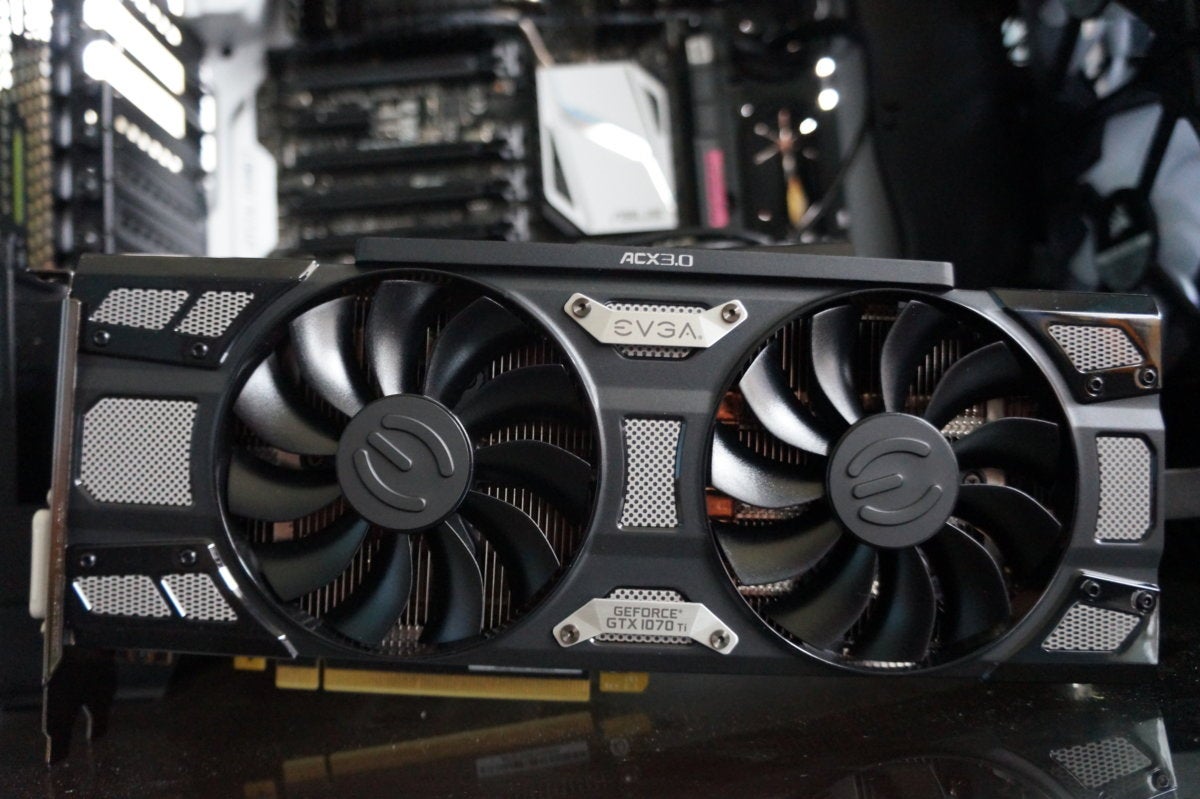 Brad Chacos/IDG
Brad Chacos/IDGThe EVGA GTX 1070 Ti SC Black Edition.
Nvidia’s aiming to eradicate the Radeon Vega 56’s lead in yet another way. While customized RX Vega graphics cards have yet to appear, months after AMD’s GPU released, a full range of custom GTX 1070 Ti cards will be available at launch.
Mentioned in this article
GTX 1080 FTW
 Read our reviewPrice When Reviewed:$679.99Best Prices Today:$579 at Walmart | $599.99 at Amazon
Read our reviewPrice When Reviewed:$679.99Best Prices Today:$579 at Walmart | $599.99 at Amazon
We’re also reviewing the EVGA GTX 1070 Ti SC Black Edition, which costs $20 more than Nvidia’s Founders Edition. The GTX 1070 Ti SC Black Edition carries over the design from EVGA’s other Black Edition cards. In addition to a fancy LED logo and a 5+1 power phase configuration that noses out the Founders Edition’s setup, it sports the same ACX 3.0 cooler that impressed us so much on the EVGA GTX 1080 FTW.
Here’s how we described ACX 3.0 in that review:
“The new generation of EVGA’s vaunted custom-cooling solution features a pair of massive 100mm fans that shut off in low power scenarios and contain double ball-bearings that help them last up to four times longer than competing cards, EVGA claims. Those sit over a full-sized set of heat sink fans, with the GPU itself covered by a large copper plate with six heat pipes of various sizes snaking out of it.”
 EVGA
EVGAEVGA’s custom ACX 3.0 cooling solution.
You’ll see how effective ACX 3.0 performs later in our review. But perhaps the most interesting part of the EVGA GTX 1070 Ti SC Black Edition’s spec sheet is its clock speed rating: 1,607MHz base/1,683MHz boost “plus.” In fact, every card in EVGA’s GTX 1070 Ti lineup—including the beefy, high-end $500 FTW2 model—lists the exact same clock speeds. And if you look at the clock speeds on custom GTX 1070 Ti graphics cards from other manufacturers, they all do too. What gives?
Simple: Nvidia isn’t allowing customized GTX 1070 Ti cards to be overclocked out of the box—presumably to keep overclocked versions of this step-down card from challenging the top-end GTX 1080. Here’s what Nvidia’s Bryan Del Rizzo said when I asked about it.
“GeForce GTX 1070 Ti lives in the small price band between the GTX 1070 and GTX 1080. Given the number of products in this category we are aiming to simplify the stack-up, and let gamers get the extra performance through manual overclocking.”
Massive, massive bummer. But as he says, manual overclocking is still allowed, and because of that the restriction isn’t stopping Nvidia’s hardware partners from developing workarounds to drive their graphics cards to faster speeds.
How to use EVGA’s GTX 1070 Ti auto-overclocking tool
EVGA’s Precision XOC software is typically used by enthusiasts to overclock their GeForce graphics cards manually. But EVGA developed a new version of its Precision XOC overclocking and monitoring software with “an exclusive feature for the GTX 1070 Ti”: an auto-overclocking tool that scans your card and automatically applies an “optimal overclock” with no technical know-how needed on your end.
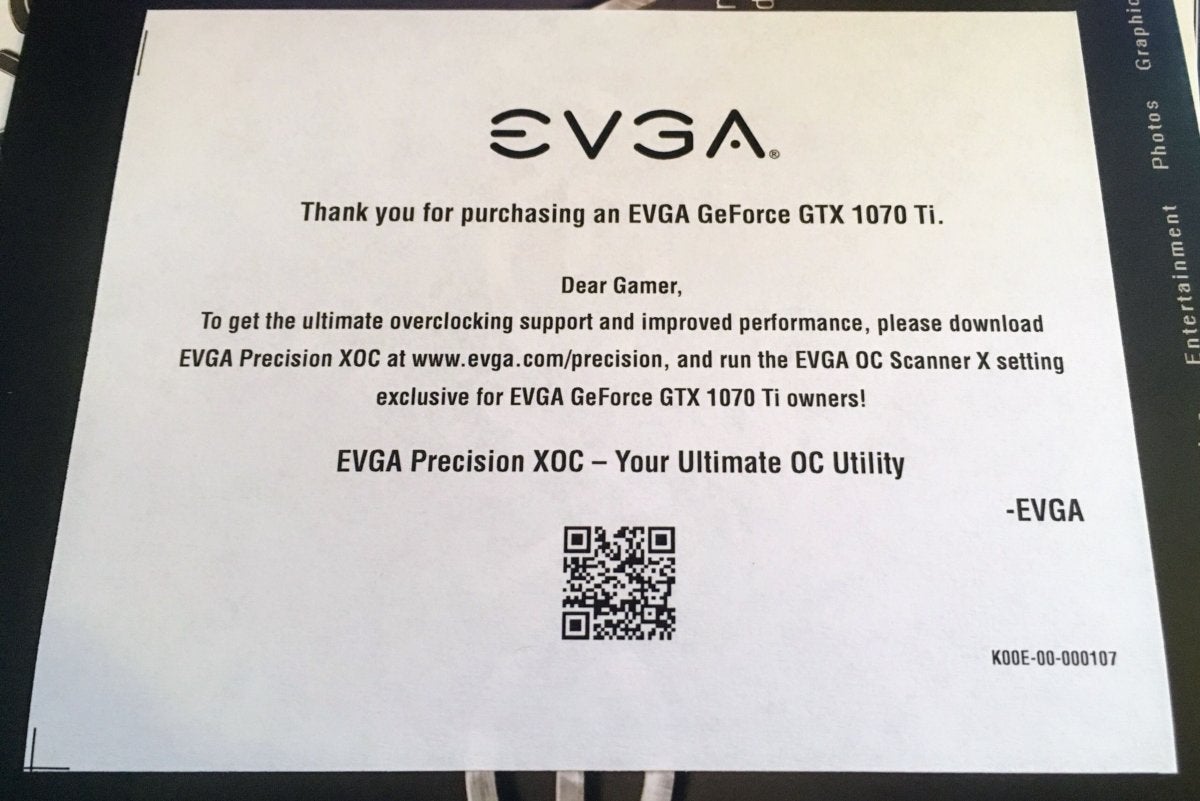 Brad Chacos/IDG
Brad Chacos/IDGThe Precision XOC tool lets EVGA work around the GTX 1070 Ti’s clock speed lockdown, and the packaging materials make sure you know it.
The packaging for the EVGA GTX 1070 Ti SC Black Edition (and its other GTX 1070 Ti models) includes a slip of paper with a QR code emblazoned on it, directing you to the company’s Precision XOC software. You’ll have to register with your name and email address to use the software, and the auto-overclocking process requires you to input your card’s serial number, in case Q.A. help winds up being required. You can find the serial number on a sticker on the back of the EVGA GTX 1070 Ti SC Black Edition as well as on the card’s box.
Precision XOC will automatically detect your GTX 1070 Ti the first time it launches and offer to “Run EVGA Precision XOC scanner” on it—that’s the auto-overclocking tool. Agree and you’ll be presented with three options. The quick scan cycles through preset overclocking ranges appropriate to your card, and takes 15 to 20 minutes. A full scan thoroughly tests your hardware to create a custom overclock more precisely tuned to your particular graphics card, but it can take up to an hour. Finally, as always, you can manually overclock the EVGA GTX 1070 Ti SC Black Edition.
 EVGA
EVGAUsing Precision XOC’s auto-overclocking tool for the EVGA GTX 1070 Ti SC Black Edition is easy-peasy.
I ran the quick scan on my model, as I’m guessing that’s what most people will do—and it was dead simple. The EVGA Precision XOC Scanner ran for 17 minutes, and then applied a solid +101MHz overclock to the card. In practice, that resulted in clock speeds of 1,924MHz to 1,949MHz running The Division at 4K resolution, and up to 1,974MHz at 1440p.
Mentioned in this article
EVGA GeForce GTX 1070 Ti FTW2
 Price When Reviewed:$499.99Best Prices Today:$699 at Amazon
Price When Reviewed:$499.99Best Prices Today:$699 at Amazon
You could no doubt push performance higher by manually tinkering with the card’s power target, overclock, and memory speeds, but a 101MHz boost is respectable indeed, and we used EVGA’s configured overclock to test the GTX 1070 Ti SC Black Edition in our performance benchmarks. A card like the EVGA GTX 1070 Ti FTW2 ($500 on Amazon) could presumably hit even higher marks, as it includes EVGA’s revolutionary iCX cooling technology and a 235-watt maximum power draw, compared to the SC Black Edition’s 217W. Cooling and available power can play a major difference in overclocking.
If you accidentally close the Precision XOC Scanner or want to run the auto-overclocking tool again, you can do so by clicking the yellow arrow icons in the software’s interface until you’re on the Basic OC Scanner page, then clicking Run. It’ll restart the process.
Whew, that was a long diversion—but a necessary one if you buy a custom GTX 1070 Ti. Let’s dig into how this hardware handles!
Next page: Our test system, performance benchmarks begin!
Our test system
We tested the GTX 1070 Ti and EVGA’s GTX 1070 Ti Black Edition on PCWorld’s dedicated graphics card benchmark system. Our testbed’s loaded with high-end components to avoid bottlenecks in other parts of the system and show unfettered graphics performance.
Intel’s Core i7-5960X with a Corsair Hydro Series H100i closed-loop water cooler ($110 on Amazon).An Asus X99 Deluxe motherboard.16GB Corsair’s Vengeance LPX DDR4 memory ($195 on Amazon).EVGA Supernova 1000 G3 power supply ($190 on Amazon).A 500GB Samsung 850 EVO SSD, PCWorld’s pick for the best SSD ($150 on Amazon).Corsair Crystal Series 570X case, deemed Full Nerd’s favorite case of 2016 ($180 on Amazon).Windows 10 Pro ($190 on Amazon).
We’re comparing the GTX 1070 cards against AMD’s Vega duo, the $399 Radeon RX Vega 56 and $499 air-cooled RX Vega 64. Both were benchmarked using the Balanced power profile on the stock BIOS. Of course, because the GTX 1070 Ti was designed to slot between the (theoretically) $350 Nvidia GeForce GTX 1070 and $500 GTX 1080, we’re testing those as well. All of the cards are reference models except the EVGA GTX 1070 Ti SC Black Edition (obviously), which we tested in both its out-of-the-box configuration as well as with Precision XOC’s new one-button overclock feature. We discussed the details of our overclock in the previous section.
Each game is tested using its in-game benchmark at the mentioned graphics presets, with VSync, frame rate caps, and all GPU vendor-specific technologies—like AMD TressFX, Nvidia GameWorks options, and FreeSync/G-Sync—disabled. Given the capabilities of these particular cards, we’re testing at 1440p and 4K resolutions alone. They’d all scream at 1080p. Every card was tested using the most current drivers available from AMD and Nvidia.
GeForce GTX 1070 Ti benchmarks
The Division
The Division ($50 on Amazon), a gorgeous third-person shooter/RPG that mixes elements of Destiny and Gears of War, kicks things off with Ubisoft’s Snowdrop engine. We test the game in DirectX 11 mode.
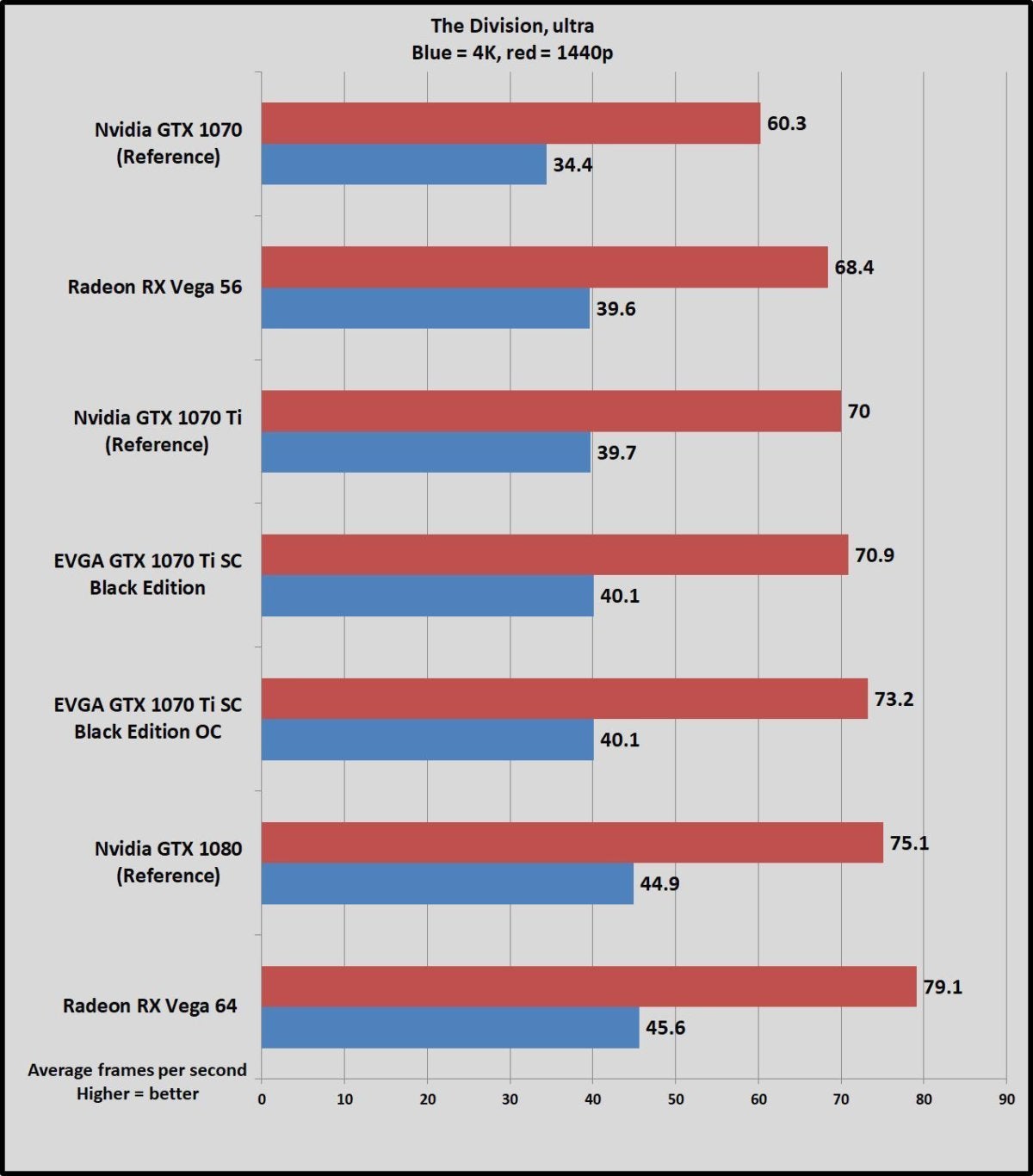 Brad Chacos/IDG
Brad Chacos/IDGThe GTX 1070 Ti Founders Edition essentially draws even with the Radeon Vega 56 here, and splits the performance difference between the GTX 1070 and GTX 1080. Out of the box, the EVGA GTX 1070 Ti SC Black Edition does the same, but with Precision XOC’s auto-overclock applied, it squeezes out a 4.5-percent frame rate increase at 1440p resolution.
Next page: Ghost Recon: Wildlands
Ghost Recon: Wildlands
Next up: Ghost Recon: Wildlands ($60 on Amazon), a stunningly beautiful and notoriously punishing game based on Ubisoft’s Anvil engine. Not even the GTX 1080 Ti can put in a decent showing at Ultra graphics settings at 4K, so we test at Very High, which “is targeted to high-end hardware.” It’s a game that includes some Nvidia GameWorks features, but again, we test with those disabled.
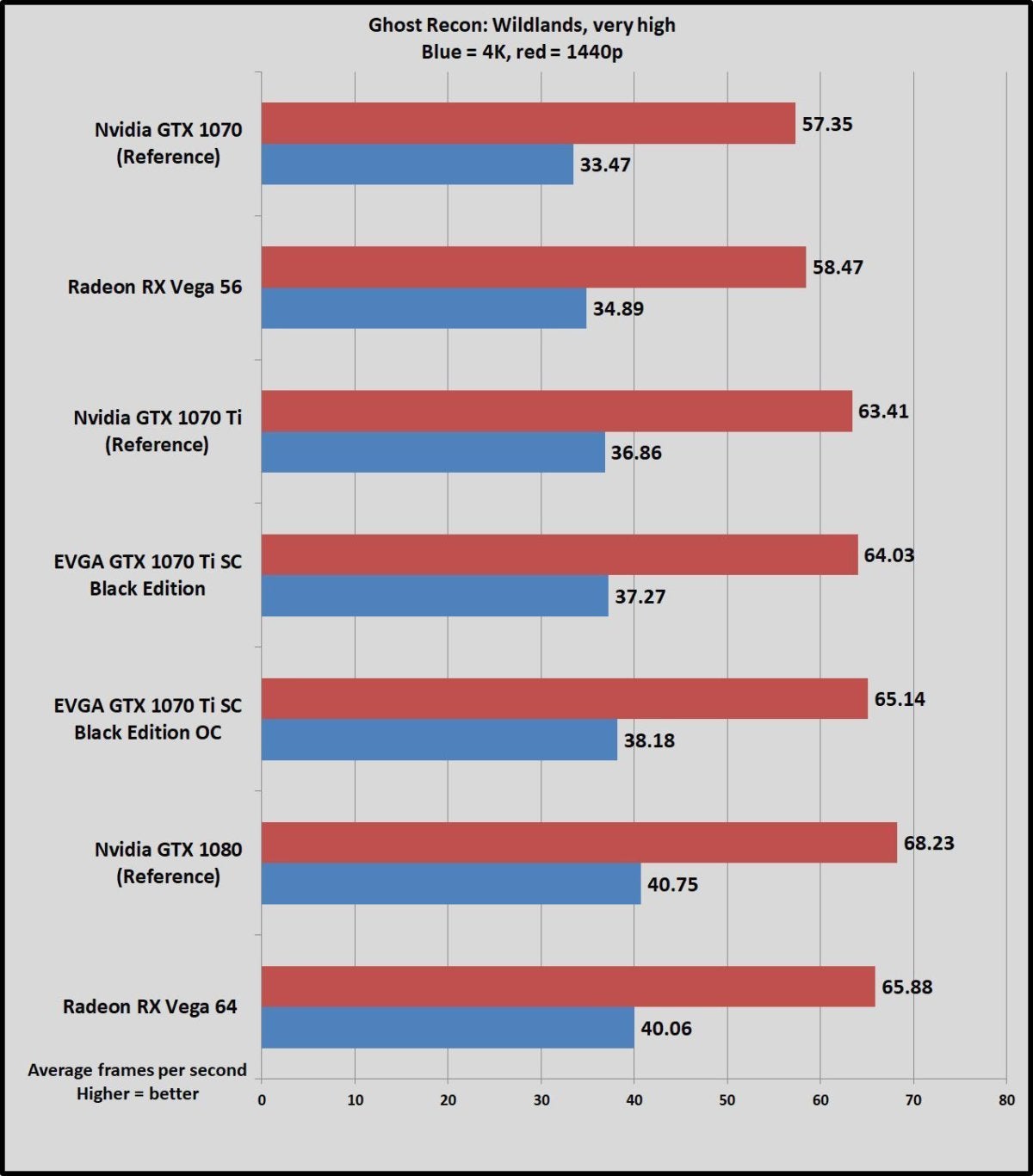 Brad Chacos/IDG
Brad Chacos/IDGThis strenuous game challenges all of these cards at 4K resolution. While the Radeon Vega 56 barely surpassed the original GTX 1070 in performance, the GTX 1070 Ti pushes straight past it, though once again the difference is less noticeable at 4K resolution. Once again, Nvidia’s GTX 1070 Ti Founders Edition falls squarely in between its cousins. EVGA’s custom card doesn’t provide much uplift in this game even with the auto-applied overclock, but this game’s a beast.
Next page: Deus Ex: Mankind Divided
Deus Ex: Mankind Divided
Now it’s time for another graphically punishing game, but this one favors AMD hardware. Deus Ex: Mankind Divided ($15 on Amazon) replaces Hitman in our test suite because its Dawn engine is based upon the Glacier Engine at Hitman’s heart. We dropped all the way down to the High graphics preset for this one and still struggled at 4K. We tested in DirectX 12 as that mode lifts all performance boats regardless of which brand’s GPU sits at the heart of your graphics card.
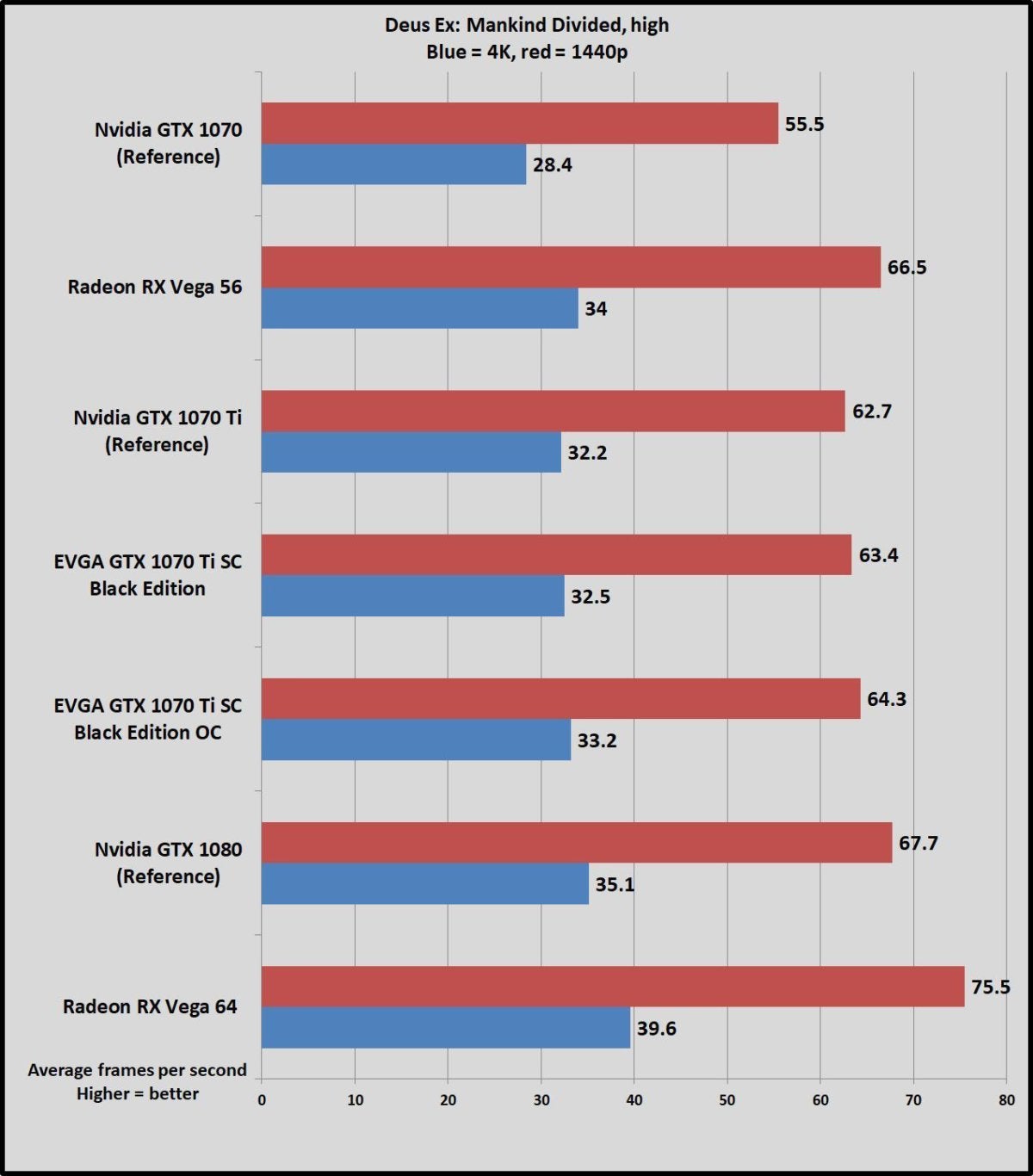 Brad Chacos/IDG
Brad Chacos/IDGLike I said: Deus Ex heavily favors AMD hardware, to the extent that the GTX 1080 barely stays ahead of even the Radeon Vega 56 at 1440p. That said, the GTX 1070 Ti puts up admirable numbers versus its AMD rival, which flat-out pummels the vanilla GTX 1070.
Next page: Rise of the Tomb Raider
Rise of the Tomb Raider
Rise of the Tomb Raider ($60 on Amazon) tends to perform better on GeForce cards, on the other hand. It’s utterly gorgeous and one of the first games to receive specific optimizations for AMD’s new Ryzen processors (not that it matters in this comparison, as we’re using an Intel processor).
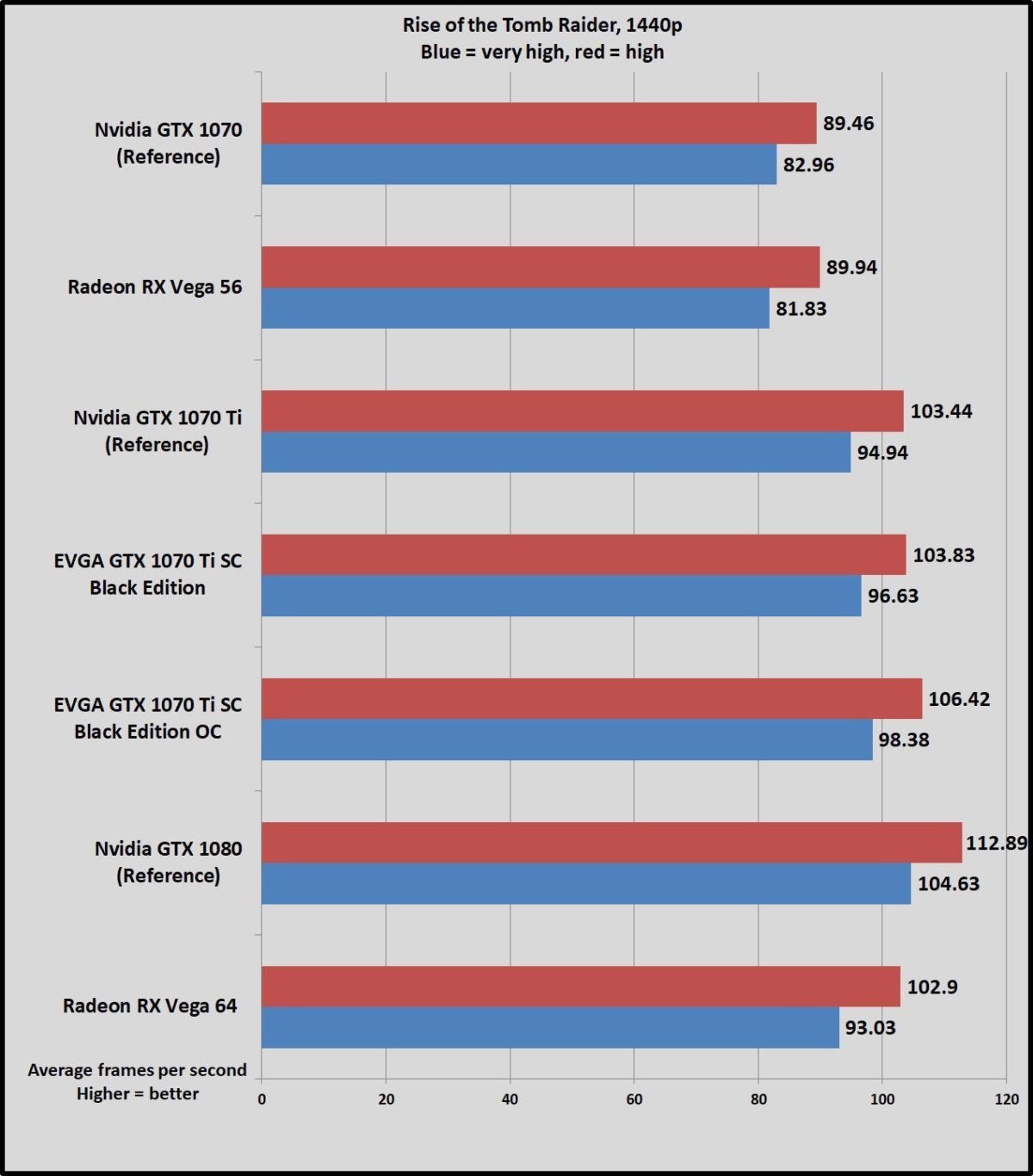 Brad Chacos/IDG
Brad Chacos/IDG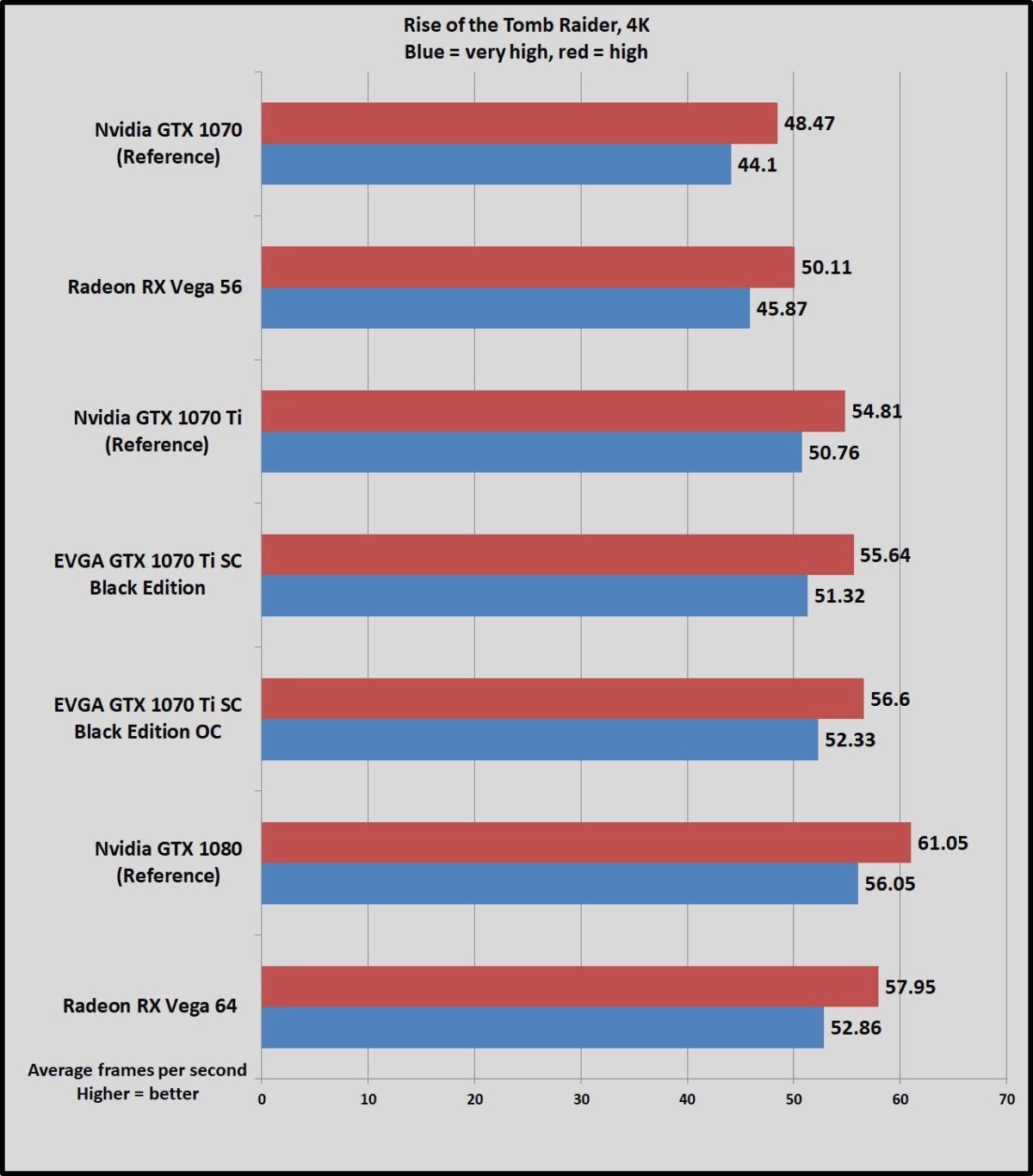 Brad Chacos/IDG
Brad Chacos/IDGLike I said: Rise of the Tomb Raider heavily favors Nvidia hardware. While the Radeon Vega 56 managed to beat the baseline GTX 1070 by the barest of margins, the GTX 1070 Ti comes close to Vega 64 levels of performance at 4K—especially EVGA’s overclocked-boosted Black Edition. And it outright bests the flagship Vega 64 at 1440p.
Next page: Far Cry Primal
Far Cry Primal
Far Cry Primal ($55 on Amazon) is yet another Ubisoft game, but it’s powered by the latest version of the long-running and well-respected Dunia engine. We benchmark the game with the optional Ultra HD texture pack enabled for high-end cards like these.
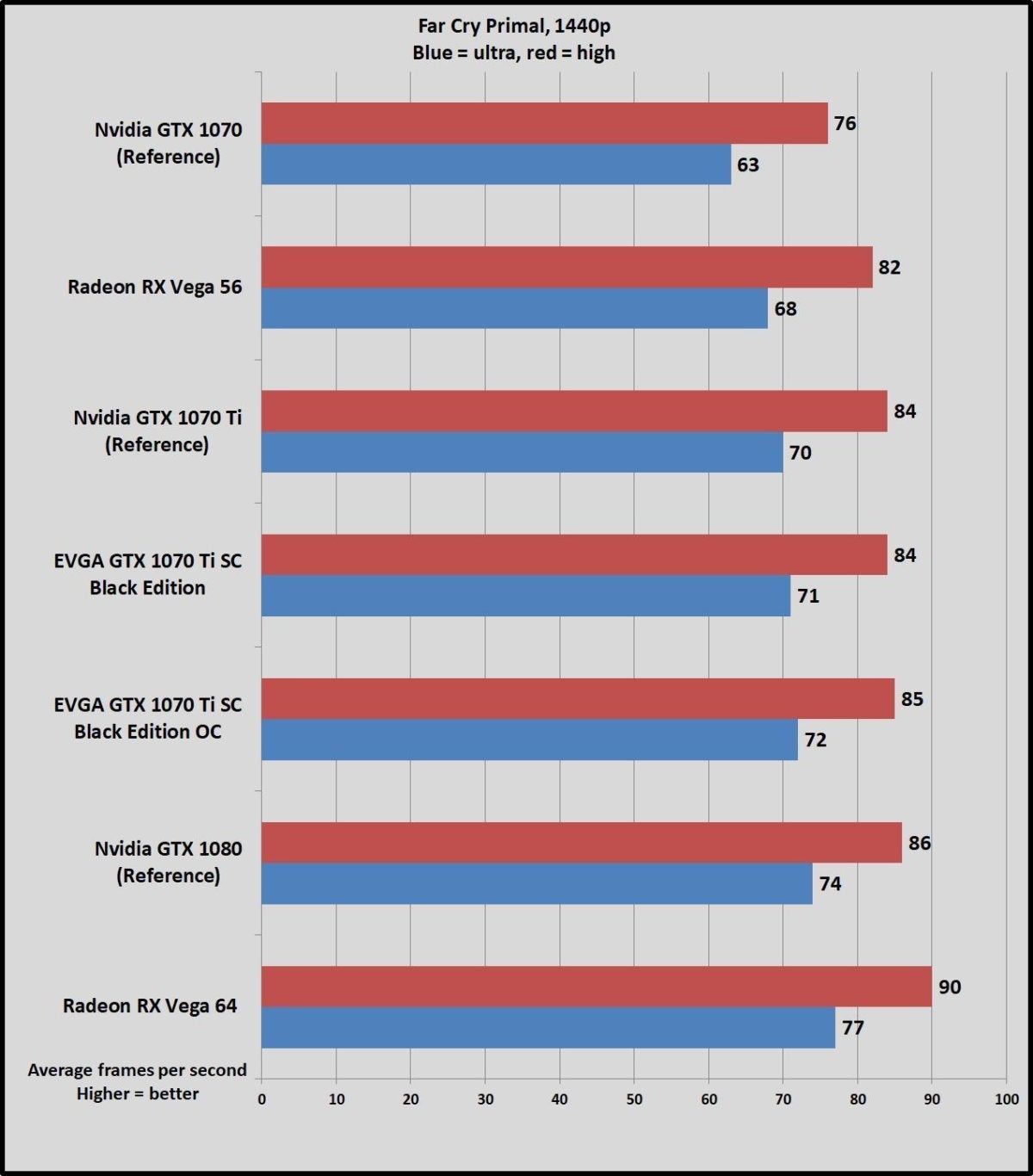 Brad Chacos/IDG
Brad Chacos/IDG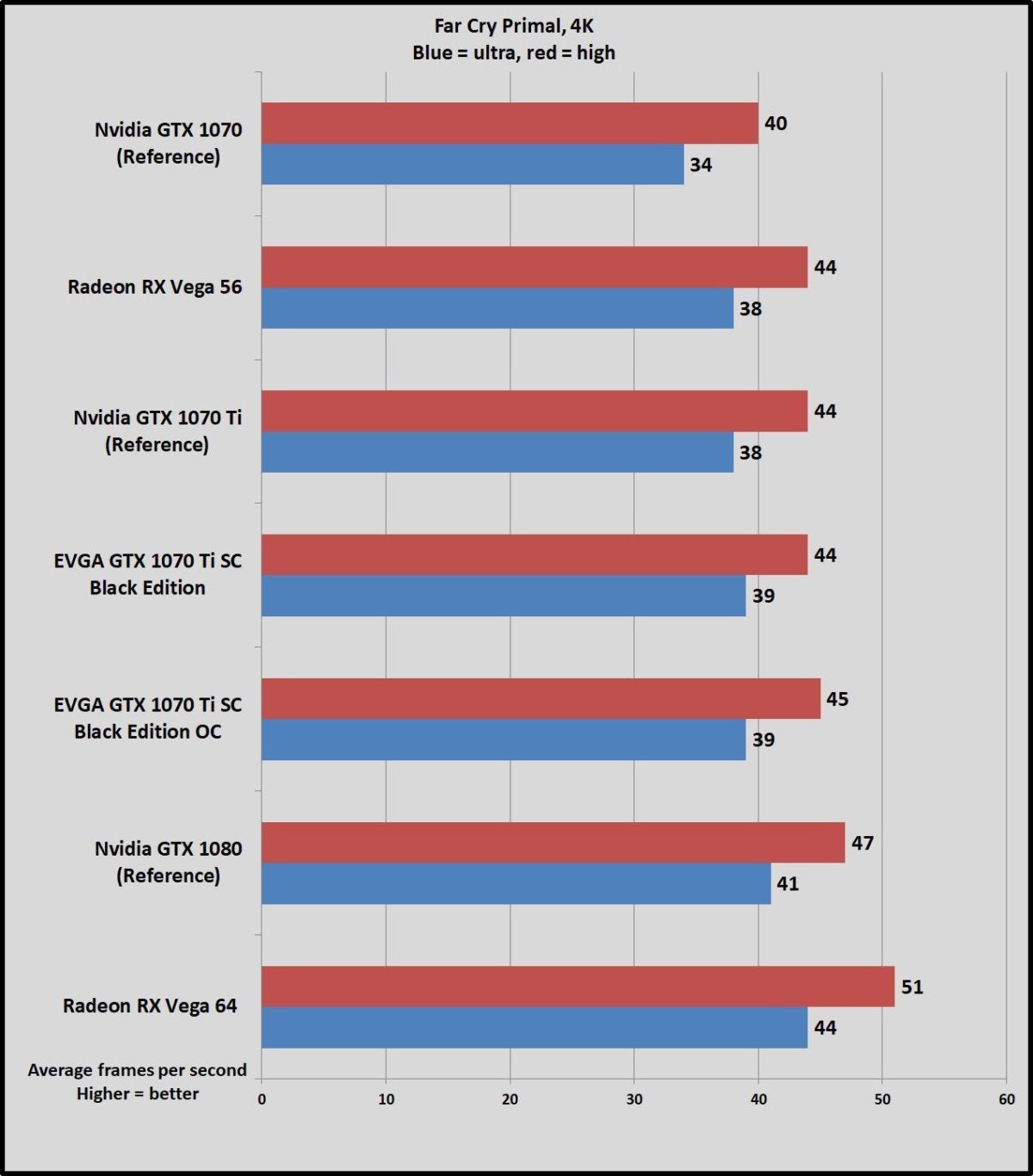 Brad Chacos/IDG
Brad Chacos/IDGThe GTX 1070 Ti manages to match or slightly beat the Radeon Vega 56 depending on the resolution and settings you’re using, and the OC’d EVGA GTX 1070 Ti Black Edition manages to nudge that. We’re talking imperceptible zero to 4-fps differences from worst to best, though.
Next page: Ashes of the Singularity
Ashes of the Singularity
Ashes of the Singularity ($40 on Steam), running on Oxide’s custom Nitrous engine, was an early standard-bearer for DirectX 12. Many months later it’s still the premier game for seeing what next-gen graphics technologies have to offer. Nvidia drivers have greatly improved GeForce performance in Ashes over the past several months. We test the game using the High graphics setting, as the wildly strenuous Crazy and Extreme presets aren’t reflective of real-world usage scenarios.
 Brad Chacos/IDG
Brad Chacos/IDG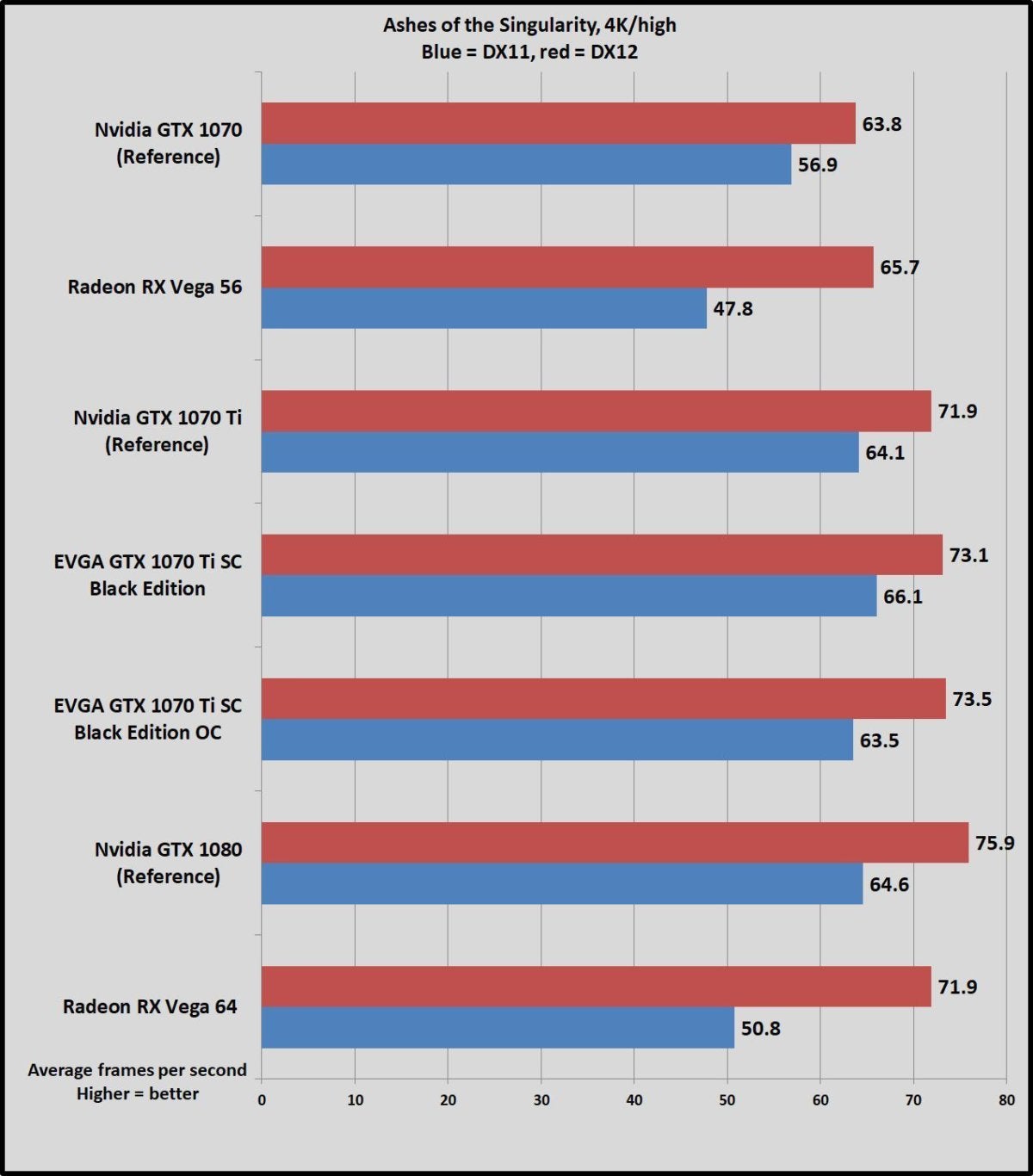 Brad Chacos/IDG
Brad Chacos/IDGThis game traditionally favored Radeon hardware, but after a slew of DirectX 12 driver improvements by Nvidia, the GTX 1070 Ti trounces the Vega 56 and matches Vega 64 in performance. The difference is even more pronounced if you don’t have Windows 10 and thus can’t utilize DX12. In DirectX 11, the GTX 1070 Ti beats Vega 56 by nearly 20 fps. Hot damn.
Next page: Synthetic benchmarks
Power, heat, noise, clock speeds
Power
We test power under load by plugging the entire system into a Watts Up meter, running the intensive Division benchmark at 4K resolution, and noting the peak power draw. Idle power is measured after sitting on the Windows desktop for three minutes with no extra programs or processes running.
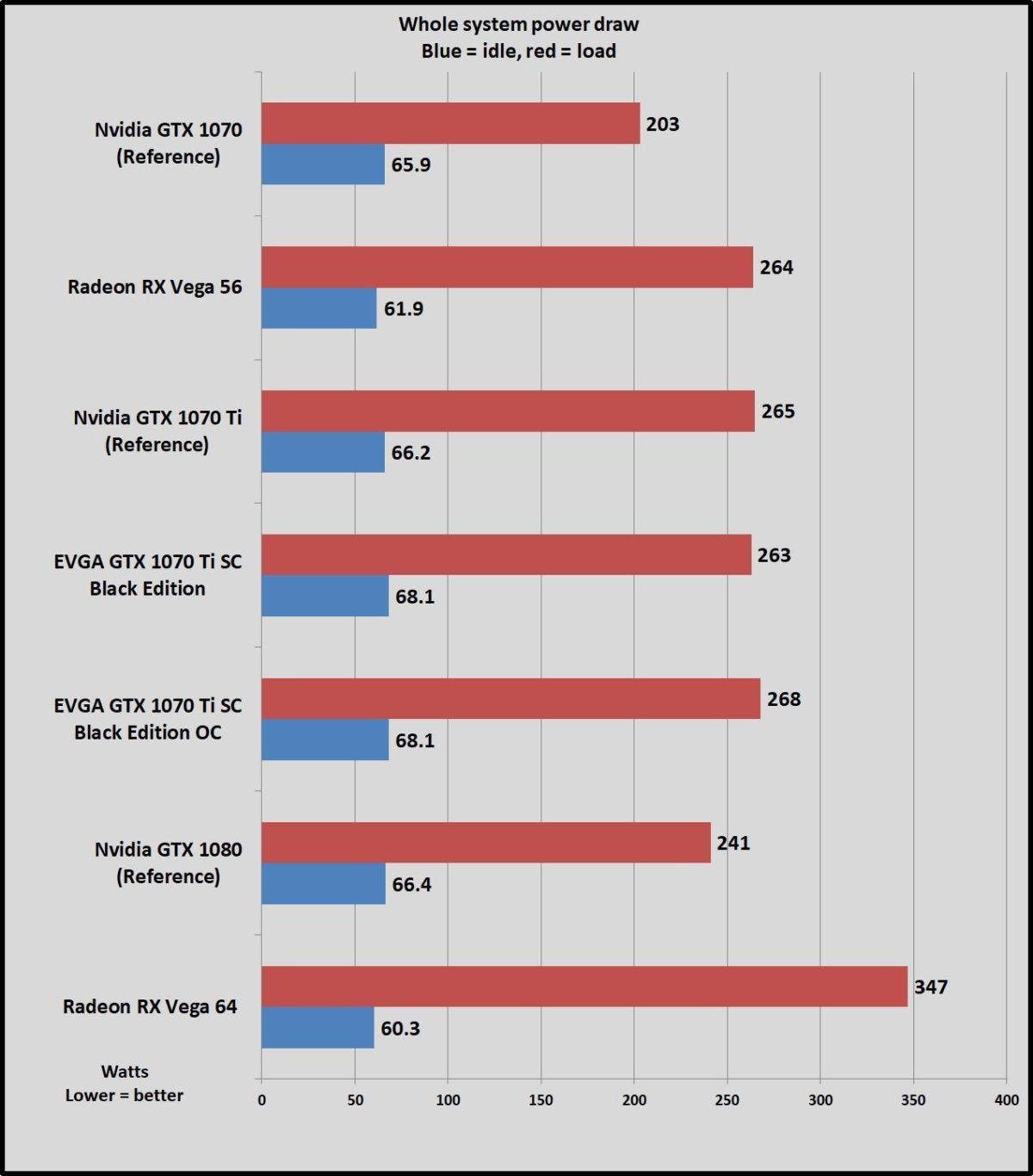 Brad Chacos/IDG
Brad Chacos/IDGThe Vega 64 still stands out as a ridiculous power hog here, but the differences—or lack thereof—between the GTX 1070 Ti and Radeon Vega 56 are much more interesting. Because the GTX 1070 Ti largely matches the GTX 1080’s GPU layout and uses GDDR5 memory instead of power-efficient GDDR5X, it draws a lot more power than the vanilla GTX 1070 does. In fact, it essentially ties the Vega 56 on that front.
Heat and noise
We test heat during the same intensive Division benchmark at a strenuous 4K resolution, by running SpeedFan in the background and noting the maximum GPU temperature once the run is over.
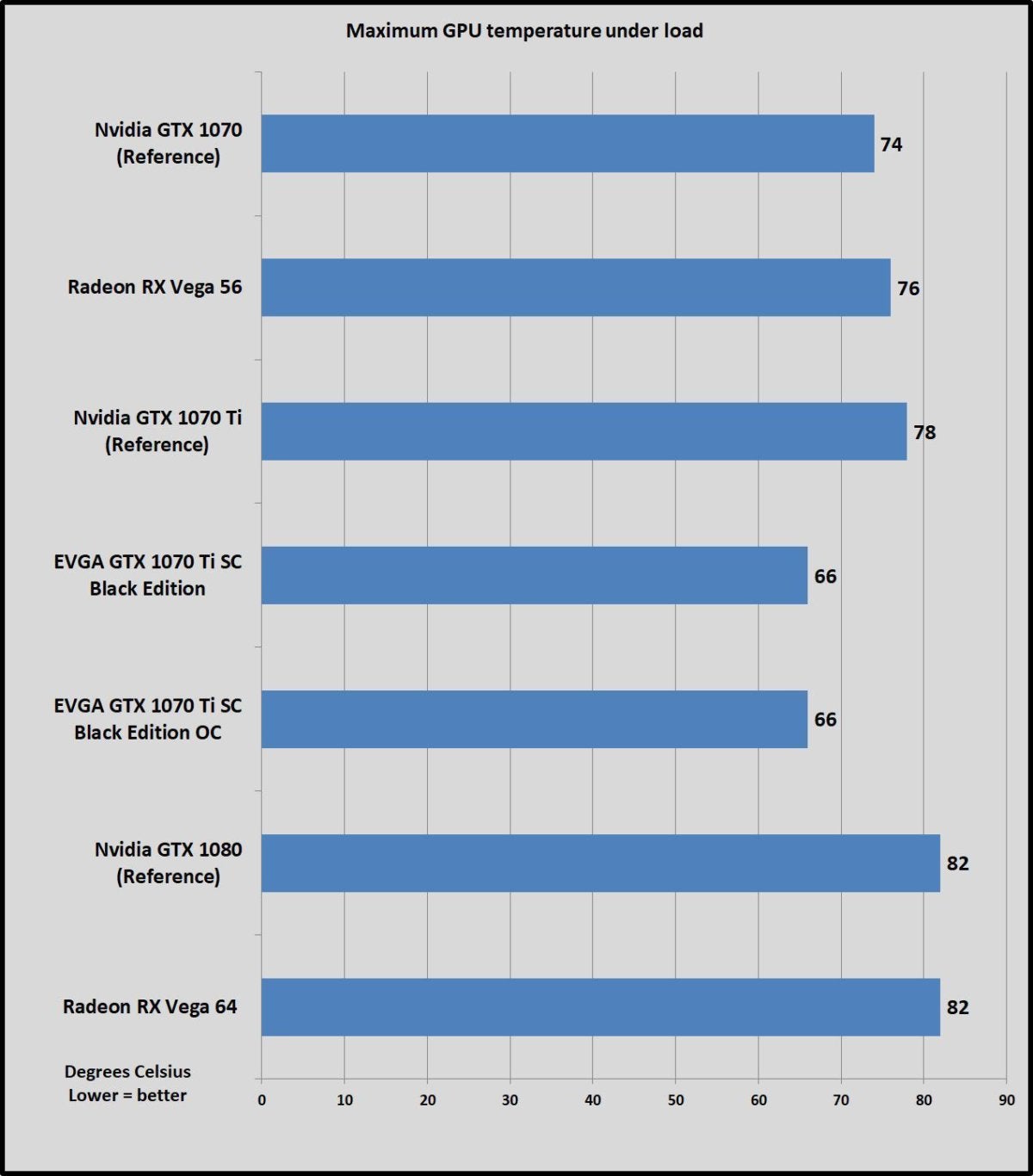 Brad Chacos/IDG
Brad Chacos/IDGAgain, the GTX 1070 Ti Founders Edition and Vega 56 are in a dead heat. (Get it?) Both cards use blower-style coolers, but despite the equality in temperature, Nvidia’s implementation is vastly superior to AMD’s. The ghastly Vega coolers are the loudest I’ve heard since the old Radeon 290X days. Seriously, it’s loud enough to distract you unless you’re wearing noise-proof headphones, and that’s a rare find in modern GPUs.
But the EVGA GTX 1070 Ti SC Black Edition’s superb ACX 3.0 cooling solution stands heads-and-shoulders above the reference cards. It not only runs far, far chillier, it manages to run much quieter than the others while doing so. Two fans are better than one, it seems.
Next page: Bottom line and buying advice
GeForce GTX 1070 Ti vs Radeon Vega 56
How does the GeForce GTX 1070 Ti compare to the Radeon Vega 56? The answer’s complicated, and made more so by cryptocurrency miners driving up prices in this market segment.
Nvidia met its goal. The GeForce GTX 1070 Ti Founders Edition ($450 on Nvidia) matches or beats the Radeon Vega 56 in every game we tested except Deus Ex: Mankind Divided, which skews heavily towards AMD hardware. And it bests the AMD card heavily in Rise of the Tomb Raider and Ashes of the Singularity. But power and heat are a wash and the performance victories are minimal in most situations we’ve tested. Given that AMD’s glorious, tear- and stutter-killing FreeSync variable refresh rate monitors are much more affordable than Nvidia’s comparable G-Sync displays, and the GTX 1070 Ti starts at $50 more than the Radeon RX Vega 56’s $400 suggested pricing, you can make an argument for these cards being of roughly equal value.
At least in theory.
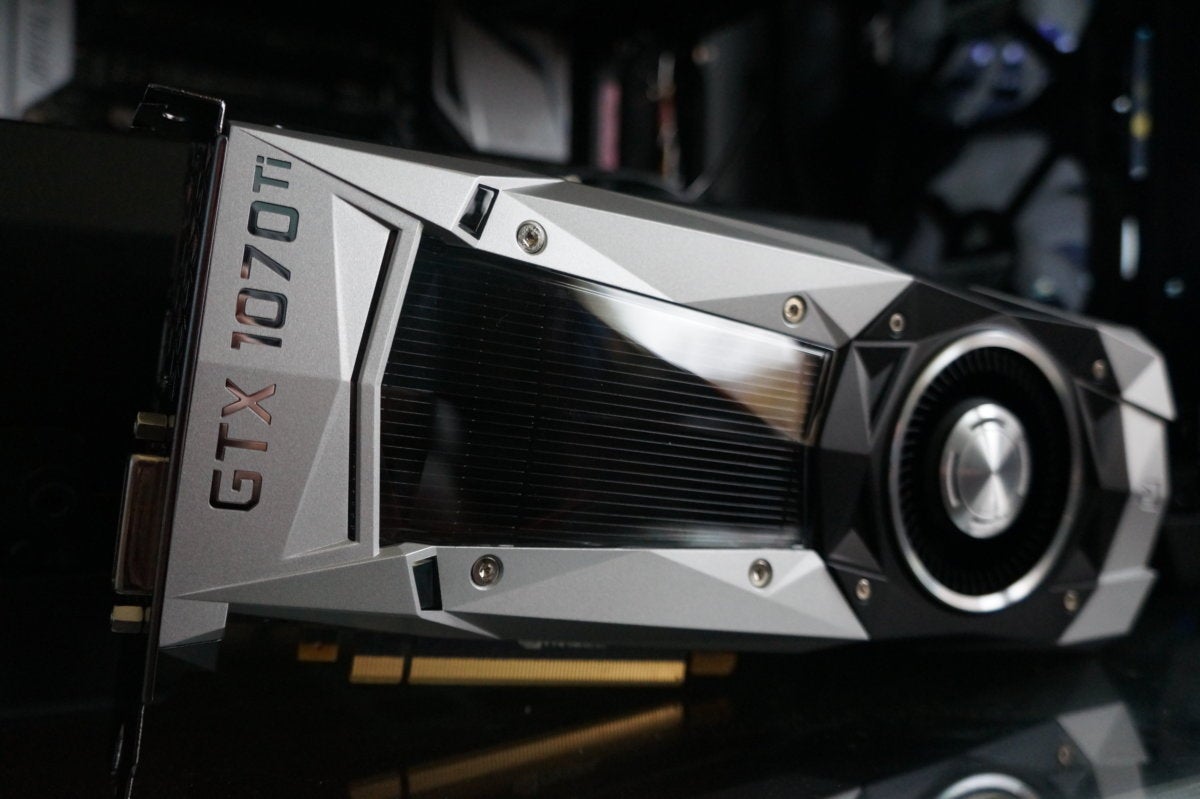 Brad Chacos/IDG
Brad Chacos/IDGMentioned in this article
XFX Radeon RX Vega 56
 Price When Reviewed:$579.99Best Prices Today:$449 at Amazon
Price When Reviewed:$579.99Best Prices Today:$449 at Amazon
In reality, the Radeon Vega 56 has barely come close to approaching its suggested pricing since five minutes after the card launched in August. Sure, there’s a Sapphire Vega 56 for $400 at Microcenter right now, but that’s in-store pickup only and on “sale” from $530. As I’m writing this on November 1, there’s a single XFX Vega 56 available for $400 on Amazon and $420 on Newegg, but all others cost more than $500… and it just turned up at those prices today. I’ve been tracking Vega 56 prices on Newegg since the GTX 1070 Ti’s announcement last week, and most sold for $470—$20 more than Nvidia’s Founders Edition card, and the same price as the superior EVGA GTX 1070 Ti SC Black Edition.
The GTX 1070 Ti probably wouldn’t exist if Vega 56 didn’t exist, but it’s cards like the EVGA GTX 1070 Ti SC Black Edition that make Vega 56 moot in today’s bizarre market. The world is still waiting for custom cards month after Vega’s launch. In the meantime, the Radeon Vega reference cooler sounds like a damned hurricane. That alone makes it impossible to recommend over EVGA’s (in reality) identically priced GTX 1070 Ti, which delivers more performance while staying cool and running awfully quiet.
If Radeon Vega 56 ever hits its suggested price and custom Vega cards become available for $450 or less, the FreeSync variable may tip the scales back in AMD’s favor. But that’s not the way of the world today.
Should I buy the GeForce GTX 1070 Ti?
So should you buy the GeForce GTX 1070 Ti? Even though we recommend it over the Radeon RX Vega 56, it’s still a complicated question influenced by the cryptocurrency problem, as miners drive up prices. Why do men decide?
If you look at PCWorld’s guide to the best graphics cards—or the benchmarks in this very article—you’ll see that the vanilla $380 GTX 1070 already excels for 60-fps gaming at 2560×1440 resolution. The GTX 1080, on the other hand, is best for high refresh-rate 1440p gaming. It can handle entry-level 4K gaming if you turn down some graphics settings, but true single-card 4K/60 gaming requires the beastly $700 GTX 1080 Ti.
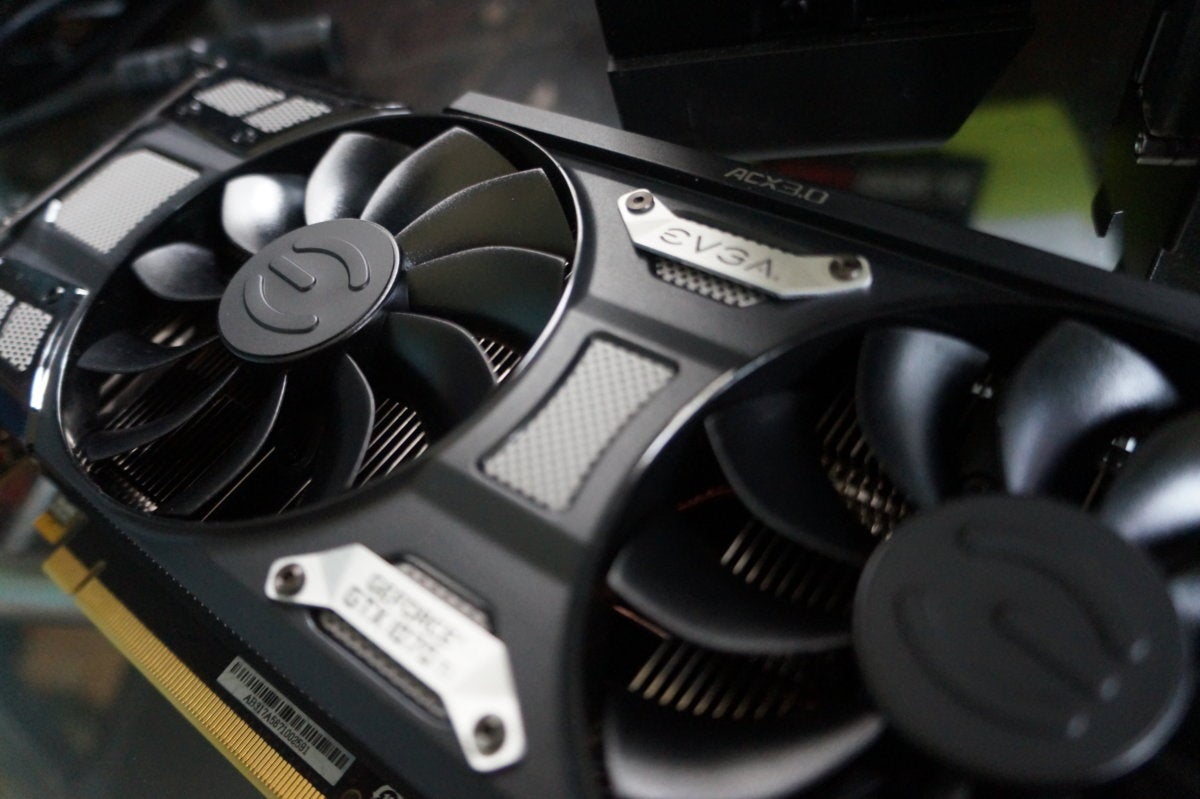 Brad Chacos/IDG
Brad Chacos/IDGThe EVGA GTX 1070 Ti SC Black Edition uses a custom ACX 3.0 cooler.
But most full-sized versions of the GTX 1070 are selling for $430 or more on Newegg right now. (Damned miners!) The significant performance increase offered by the GTX 1070 Ti is well worth the $20 to $30 extra. But saving up even more pennies for the $500-plus GTX 1080 makes less sense. The GTX 1070 Ti is plenty fast for 1440p gaming, and the biggest performance differences between the GTX 1070 Ti and GTX 1080 in our 4K tests are only about 5 fps. If you’re already turning down graphics settings to play games at 4K with the GTX 1080, you could save $50 and just turn anti-aliasing options down another notch on the GTX 1070 Ti instead.
Mentioned in this article
GTX 1070 Ti SC Black Edition
 Price When Reviewed:$469.99Best Prices Today:$570 at Amazon
Price When Reviewed:$469.99Best Prices Today:$570 at Amazon
In an ideal world—where the GTX 1070, GTX 1080, and Radeon RX Vega 56 all sold for suggested pricing, and custom Vega cards were on store shelves—the GTX 1070 Ti would be a weird and largely irrelevant release, hampered by the crap Nvidia’s pulling with the clock speeds of custom cards. But here in the real world of today’s graphics card market, it’s the best 1440p graphics card option around. Unless cryptocurrency miners drive up its prices too, of course.
The slick-looking EVGA GTX 1070 Ti SC Black Edition ($470 on Amazon) easily justifies its modest $20 upcharge thanks to its excellent ACX 3.0 cooler and the one-touch ease with which Precision XOC negates Nvidia’s ugly, artificial clock speed lockdown in customized graphics cards. But be sure to download that overclocking software to get the most out of your hardware.
Best Prices Today: GeForce GTX 1070 Ti Founders Edition
RetailerPriceNvidia$450View DealPrice comparison from over 24,000 stores worldwideProductPricePrice comparison from Backmarket